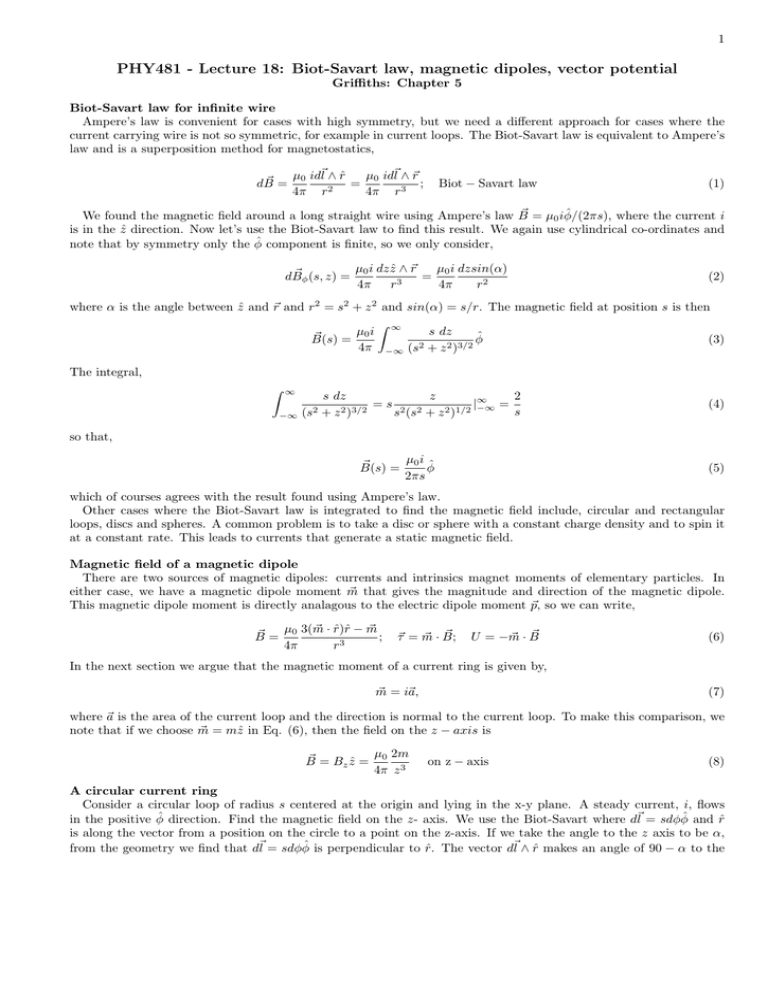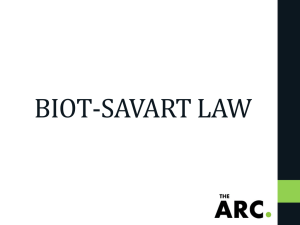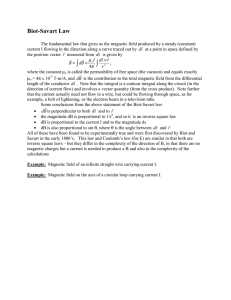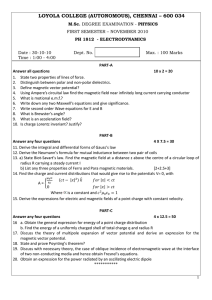PHY481 - Lecture 18: Biot-Savart law, magnetic dipoles, vector
advertisement

1 PHY481 - Lecture 18: Biot-Savart law, magnetic dipoles, vector potential Griffiths: Chapter 5 Biot-Savart law for infinite wire Ampere’s law is convenient for cases with high symmetry, but we need a different approach for cases where the current carrying wire is not so symmetric, for example in current loops. The Biot-Savart law is equivalent to Ampere’s law and is a superposition method for magnetostatics, ~ = dB µ0 id~l ∧ ~r µ0 id~l ∧ r̂ = ; 2 4π r 4π r3 Biot − Savart law (1) ~ = µ0 iφ̂/(2πs), where the current i We found the magnetic field around a long straight wire using Ampere’s law B is in the ẑ direction. Now let’s use the Biot-Savart law to find this result. We again use cylindrical co-ordinates and note that by symmetry only the φ̂ component is finite, so we only consider, ~ φ (s, z) = dB µ0 i dz ẑ ∧ ~r µ0 i dzsin(α) = 4π r3 4π r2 (2) where α is the angle between ẑ and ~r and r2 = s2 + z 2 and sin(α) = s/r. The magnetic field at position s is then Z µ0 i ∞ s dz ~ φ̂ (3) B(s) = 2 4π −∞ (s + z 2 )3/2 The integral, Z ∞ −∞ (s2 s dz z 2 =s 2 2 |∞ −∞ = 2 3/2 2 1/2 s +z ) s (s + z ) (4) so that, µ0 i ~ B(s) = φ̂ 2πs (5) which of courses agrees with the result found using Ampere’s law. Other cases where the Biot-Savart law is integrated to find the magnetic field include, circular and rectangular loops, discs and spheres. A common problem is to take a disc or sphere with a constant charge density and to spin it at a constant rate. This leads to currents that generate a static magnetic field. Magnetic field of a magnetic dipole There are two sources of magnetic dipoles: currents and intrinsics magnet moments of elementary particles. In either case, we have a magnetic dipole moment m ~ that gives the magnitude and direction of the magnetic dipole. This magnetic dipole moment is directly analagous to the electric dipole moment p~, so we can write, ~ · r̂)r̂ − m ~ ~ = µ0 3(m B ; 4π r3 ~ ~τ = m ~ · B; ~ U = −m ~ ·B (6) In the next section we argue that the magnetic moment of a current ring is given by, m ~ = i~a, (7) where ~a is the area of the current loop and the direction is normal to the current loop. To make this comparison, we note that if we choose m ~ = mẑ in Eq. (6), then the field on the z − axis is ~ = Bz ẑ = µ0 2m B 4π z 3 on z − axis (8) A circular current ring Consider a circular loop of radius s centered at the origin and lying in the x-y plane. A steady current, i, flows in the positive φ̂ direction. Find the magnetic field on the z- axis. We use the Biot-Savart where d~l = sdφφ̂ and r̂ is along the vector from a position on the circle to a point on the z-axis. If we take the angle to the z axis to be α, from the geometry we find that d~l = sdφφ̂ is perpendicular to r̂. The vector d~l ∧ r̂ makes an angle of 90 − α to the 2 z-axis and its projection onto the x-y plane is at angle φ to the x-axis. On the z-axis, by symmetry, the magnetic field points in the z-direction, and we find, Z µ0 i µ0 i 2π sin(α)sdφ s2 = (9) Bz (z) = 2 2 2 4π 0 s +z 2 (s + z 2 )3/2 Expanding the expression above at large distances, z, gives, Bz (z) ≈ 3 s2 µ0 ia µ0 is2 (1 − )≈ 2z 3 2 z2 2πz 3 (10) Comparing with Eq. (8) we see that this is the same as for a dipole provided we set m = ia. General relations for the magnetic field From Ampere’s law, we have, I Z Z ~ ~ ~ ~ B · dl = (∇ ∧ B) · d~a = µ0 i = µ0 ~j · d~a (11) leading to the differential form of Ampere’s law, ~ ∧B ~ = µ0~j ∇ Since there are no magnetic monopoles we also have, I Z ~ · d~a = (∇ ~ · B)d~ ~ r=0 B ~ ·B ~ =0 so that ∇ We can also write the general form of the Biot-Savart law for a current density ~j, Z d~r0~j(~r0 ) ∧ (~r − ~r0 ) ~ = µ0 ; Biot − Savart law B 4π |~r − ~r0 |3 (12) (13) (14) ~ ·B ~ = 0. Taking the divergence of this equation confirms that ∇ The vector potential ~ ∇∧ ~ F~ ) = 0 for any vector In magnetostatics the magnetic field is divergence free, and we have the vector identity ∇·( ~ ~ ~ ~ ~ is the vector function F , therefore if we write B = ∇ ∧ A, then we ensure that the magnetic field is divergence free. A potential, and despite being a vector simplifies the calculations in some cases. It is also very important in quantum ~ mechanics where the solution to Schrodinger’s equation in a magnetic field involves adding a term proportional to A to the momentum operator. To find a differential equation for the vector potential, we use the differential form of Ampere’s law to find, ~ ∧ (∇ ~ ∧ A) ~ = µ0~j = ∇( ~ ∇ ~ · A) ~ − ∇2 A ~ ∇ (15) where we used a vector identity to write the last expression on the RHS. This still looks messy, however now note ~ is not unique as we can write A ~ + ∇f ~ and ∇ ~ ∧A ~ is unaltered. We can then choose the scalar that the choice of A ~ ·A ~ = 0 as this removes the first term in function f to help solve problems. In electrostatics a convenient choice is ∇ the last expression on the RHS of Eq. (15). This choice is called the Coulomb gauge, and in this gauge we have, ~ = −µ0~j; ∇2 A Coulomb gauge. (16) ~ Recall that for the voltage ∇ ~ 2 V = −ρ/0 . To show This is just Poisson’s equation for each of the components of A. ~ ~ that it is always possible to find a scalar function f to ensure that ∇ · A = 0, consider a problem where we have found ~ s where ∇ ~ ·A ~ s 6= 0. We then need to find a scalar function fs so that ∇ ~ · (A ~ s + ∇f ~ s ) = 0. This reduces a solution A 2 ~ ·A ~ s . This is just Poisson’s equation again. It always has a solution, so we can always find a scalar fs to ∇ fs = −∇ ~ ~ ~ s is divergence free. so that A = As + ∇f Now that we have found that the vector potential in the Coulomb gauge obeys Poisson’s equation, the solution to these equations in integral form may be written down, Z ~ 0 3 0 Z µ0 j(~r )d r 1 ρ(~r0 )d3 r0 ~ A(~r) = ; while in electrostatics V (~ r ) = . (17) 4π |~r − ~r0 | 4π0 |~r − ~r0 |




